In an analysis of 1,000 search queries populated by sites promoting products as an affiliate, Amazon.com appeared in the top 10 results of 432 Search Engine Results Pages (SERPs).
The youngest ranking domain was just two months old, and the fifth most popular domain extension overall was .co, just ahead of .edu and .reviews.
These are small insights compared to what we wanted to see: Are ‘general’ sites like Business Insider taking over, or do single-niche affiliate sites still rank well?
s
Myself and three others recently spent a combined 200 hours analysing the 2019 November Google algorithm update.
We didn’t perform the research to ‘chase the algorithm’, but to educate ourselves on more niches where we don’t have clients, to help track ranking shifts in future updates.
We never expected to come to any kind of specific conclusion about what Google had changed, though it did seem clear that for a lot of niche-focused sites that had lost rankings, big broad ‘general’ sites had overtaken them.
As a hypothetical example, we found Business Insider now ranking for best budget toaster rather than Bob’s Toaster HQ, even though toasters are the last thing that come to mind when you think of the former.
In response to that, we wanted to perform an analysis with a more defined focus: We looked at the search results for 1,000 affiliate-populated keyphrases to see if general sites have truly taken over, or whether hyperniche sites still perform well.
Affiliate SEO appears to be a growing online business model, with a success story on our sister website becoming one of my most popular articles ever.
If you run an affiliate site yourself, or plan to, we hope you find this data interesting.
The 1,000 Affiliate-Populated Keyphrases We Analysed
It’s easy to put the phrase ‘best 2020’ into your favourite keyword research tool and export the results, but they aren’t always going to return queries where affiliate sites populate SERPs. serp api
Highly-searched phrases like ‘best careers for 2020’ or ‘best medicare plans 2020’ wouldn’t fit the bill.
For that reason, we manually selected 1,000 different queries where we knew a lot of the results would be focused on recommending the products of others. Most likely through affiliate links.
Note that we have attempted to exclusively focus on queries where physical products will be recommended. We would happily do a separate service and software analysis if this is well received.
Our hand-picked keyphrases included the likes of:
- Best electric toothbrush
- Gifts for best friends
- Budget GPU reviews
- Cheap mascara 2020
- Best portable AC
- …and many more
While picking the phrases manually was a little tedious, it also meant that we could spread our phrases across different niches.
So we didn’t just focus on the tech space but on beauty, automotive, kids, fashion, home and more.
Although there was no specific search volume we required a keyphrase to have, 95% of them receive at least 3,000 searches per month (according to Ahrefs).
For an SEO community used to reports analysing millions of search results I realise 1,000 keyphrases sounds small, but when our main goal required manually defining thousands of sites, accuracy won out over scale.
That said, we do hope to increase the number of keyphrases for the next update and scale back what we are analysing for them.
Categorising 2,197 Websites By Hand: The Entire Reason We Did This
Manually defining over 2,000 individual websites was by far the most time-consuming part of this analysis.
This could probably be improved in future updates, but our categorisation was as follows:
- General reviews site (such as Wirecutter)
- Niche affiliate site (such as The Spruce)
- Hyperniche affiliate site (such as PowerBankReviews.com – not a real site)
- General eCommerce site (such as Amazon or Walmart)
- News site (such as Forbes and Heavy)
- Forum (such as Reddit or Quora)
- Social Media (such as Twitter)
- Encyclopedia (such as Britannica or Wikipedia)
- SEO Agency (one in particular is well known amongst affiliate SEOs)
- Design agency
- YouTube
- App Store
- Crowdfunding site
Something I should be honest about upfront is that our definitions will never be perfect.
In some cases we had to make a tough call.
For example, a large section of NYMag is entirely product focused whereas the rest of the website covers news. A similar comment could be made about Business Insider.
We defined them as news sites, since that’s what they produce the most of and what they’re known for, though I accept not everyone would agree.
The primary focus of our analysis was on general review sites vs. niche affiliate sites vs. hyperniche affiliate sites, so let’s define those in a little more detail.
A general reviews site is a site clearly focused on reviewing products, but covers a broad range of niches from fashion and beauty to kitchen and car products. Wirecutter (no longer branded as The Wirecutter) is a great example of this.
A niche site is a site that covers a lot of products in a particular space (such as automotive) but not only one specific item, like tyres.
A hyperniche site is one that covers a tighter scope of products, so they might only review running shoes, or might only review power washers, with few exceptions.
Sometimes it was tough to define a site but as we primarily did this for ourselves – nobody is Googling “affiliate SERPs” from this article headline – we at least we tried our best to remain consistent.
Affiliate SERP Analysis: The Results
So are the likes of BusinessInsider and NYMag taking over affiliate search results, or is there still a ton of room for newcomers who are performing well across the board?
Below you can see how many times each type of site was present in the first 10 results of an affiliate-populated SERP.
Based on the numbers above, it’s clear that:
- A niche site-type was present in almost every single search result we looked at
- Hyperniche sites were present in almost the exact same number of SERPs as general review sites
- A news site was present in the first page of search results for almost half of our 1,000 keyphrases
Armed with this information, we wanted to see if there was anything that stood out amongst where a particular site-type ranked.
This is where things get a lot more interesting (at least to us).
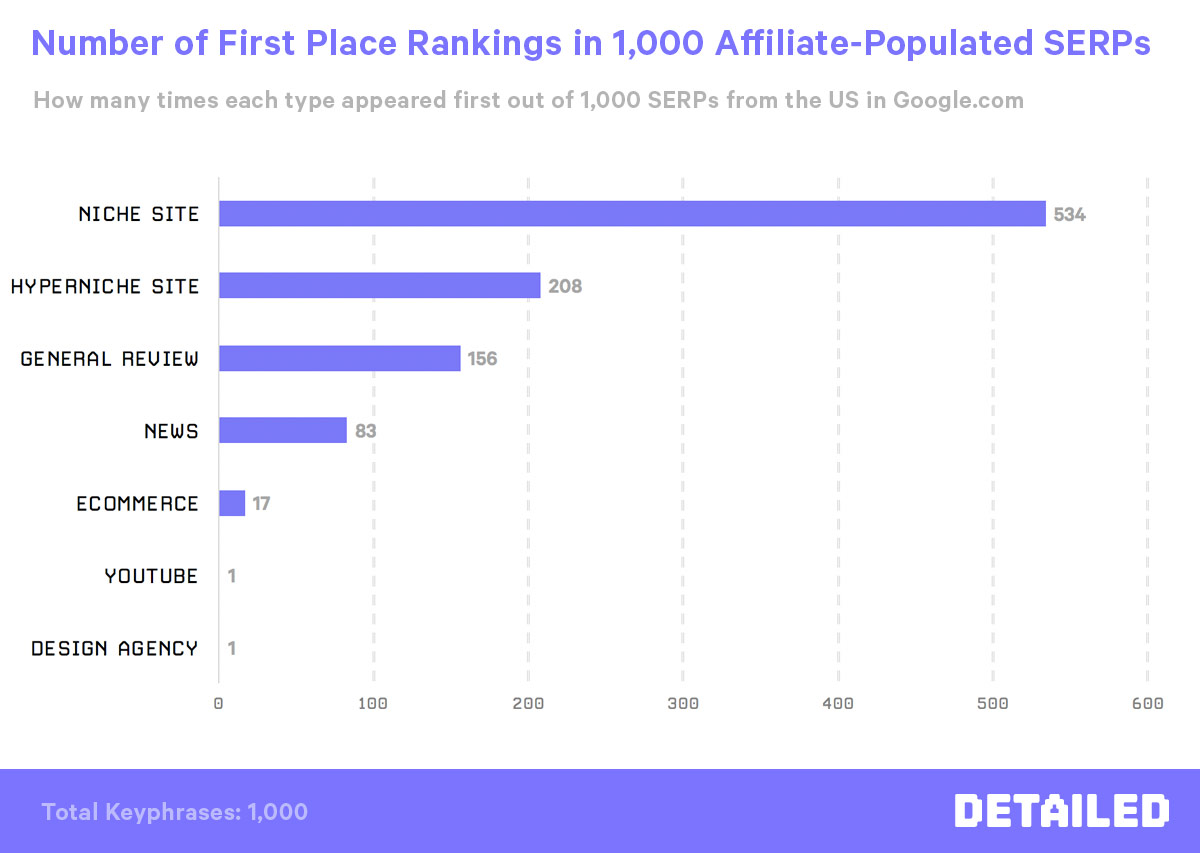
Compared to general review sites, hyperniche sites secured 33% more first place rankings, despite being present in six fewer search results.
When a niche site ranked, it was first 53.4% of the time, compared to 20.8% for hyperniche sites, a 15.6% chance for general review sites and 8.3% for news sites.
In comparison, when an eCommerce site ranked on page one, it ranked first just 1.7% of the time.
With number one rankings taken care of, what about the top three results as a whole?
After all, first position doesn’t always get all of the clicks, and one particular category might dominate positions #2 and #3.
Here’s the number of total URLs present from a particular site-type, when combining the top three ranking positions:
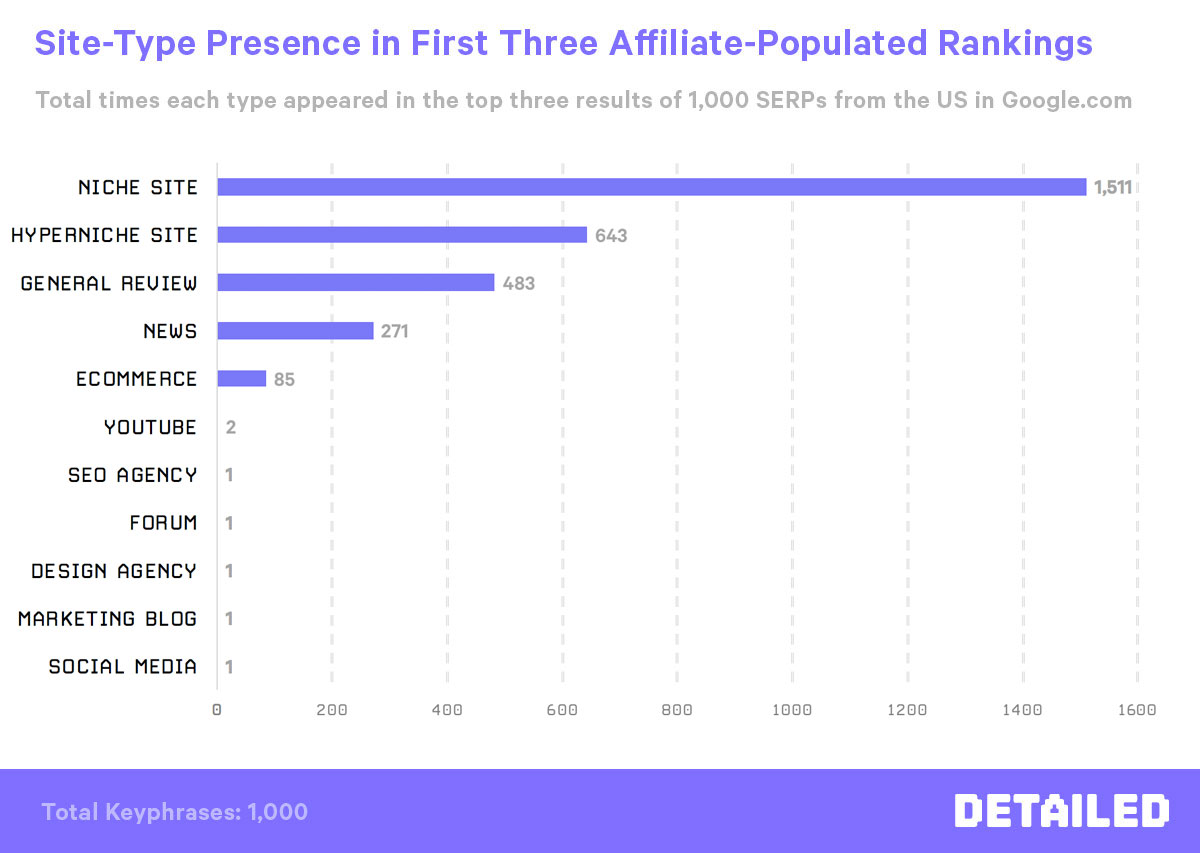
Although general review sites were present in six more SERPs than hyperniche sites, hyperniche sites secured 160 more top three rankings.
Neither directories, app stores, crowdfunding sites nor encyclopedia’s held a single top three ranking.
As you may have already guessed, we couldn’t just stop there though.
832 of the 1,000 SERPs we looked at had featured snippets (more info on SERP features later), meaning the top ranking results might not actually be getting most (or many) of the clicks.
Here are the numbers when it comes to each site-type ranking for featured snippets:

Niche sites were the clear winners once again, picking up 47.9% of all featured snippets we came across.
Hyperniche sites picked up 22.8% of all featured snippets that were present, with that number dropping to 16.7% for general review sites.
If we combine news and general review sites, which we accept some readers might want to (they both review general topics, but one can definitely be defined as a news site), they picked up 28.2% of featured snippets.
So does that mean if you want to stand the best chance of ranking with an affiliate site, you should build a niche-focused or hyperniche-focused brand?
Possibly.
There are definitely many other factors you would have to keep in mind, such as the size of the websites, their overall domain authority, links to individual pages, whether they covered a specific topic and also whether you agree with our groupings.
For example, some people might define Business Insider as a general review site, since they review products from dozens of different categories.
As they primarily cover news, we defined them as a news site, but you may disagree with that and it would definitely change the numbers above.
That said, our admittedly simplistic viewpoint does suggest having some kind of niche element to your affiliate review website will help you rank more often, and higher, than a general review site or a news site with reviews “added on”.
Even moreso when you consider that theoretically, general review sites had a higher chance of appearing in our tests as they cover a broader variety of search terms.
Despite us being happy with the results personally, you should absolutely not put your SEO future in these findings. Especially since passion, consistency and budget are far more important no matter which approach you take.
General review sites might not have secured as many top rankings as equally present hyperniche sites, but they still picked up 156 first place rankings out of a possible 1,000. General review sites that rank well are still making fortunes for their owners.
Consider this entire article a mission of professional curiosity, rather than a recommended direction you should follow.
Finally, if you skipped the introduction to this article (we don’t blame you), keep in mind that a large part of doing this analysis is so we can monitor Google algorithm updates going forward, and whether certain site-types win out at scale.
Again, that’s more for professional curiosity, rather than something you have to (or should) agree with.
Still, I hope you found the numbers above somewhat interesting, as I don’t know of any similar analysis that has been done before.
The Presence of Amazon
It wouldn’t be accurate to say that all of the sites we analysed were pointing their affiliate links to Amazon, but the vast majority of them certainly were.
Amazon, as you may know, actually “competes” with their affiliates, as they have their own guides and category pages on what the best products of a particular type are.
Because of that, we thought it would be insightful to actually see how well Amazon saturate affiliate-populated search results.
Here’s the chart that could have been a sentence but…why not:
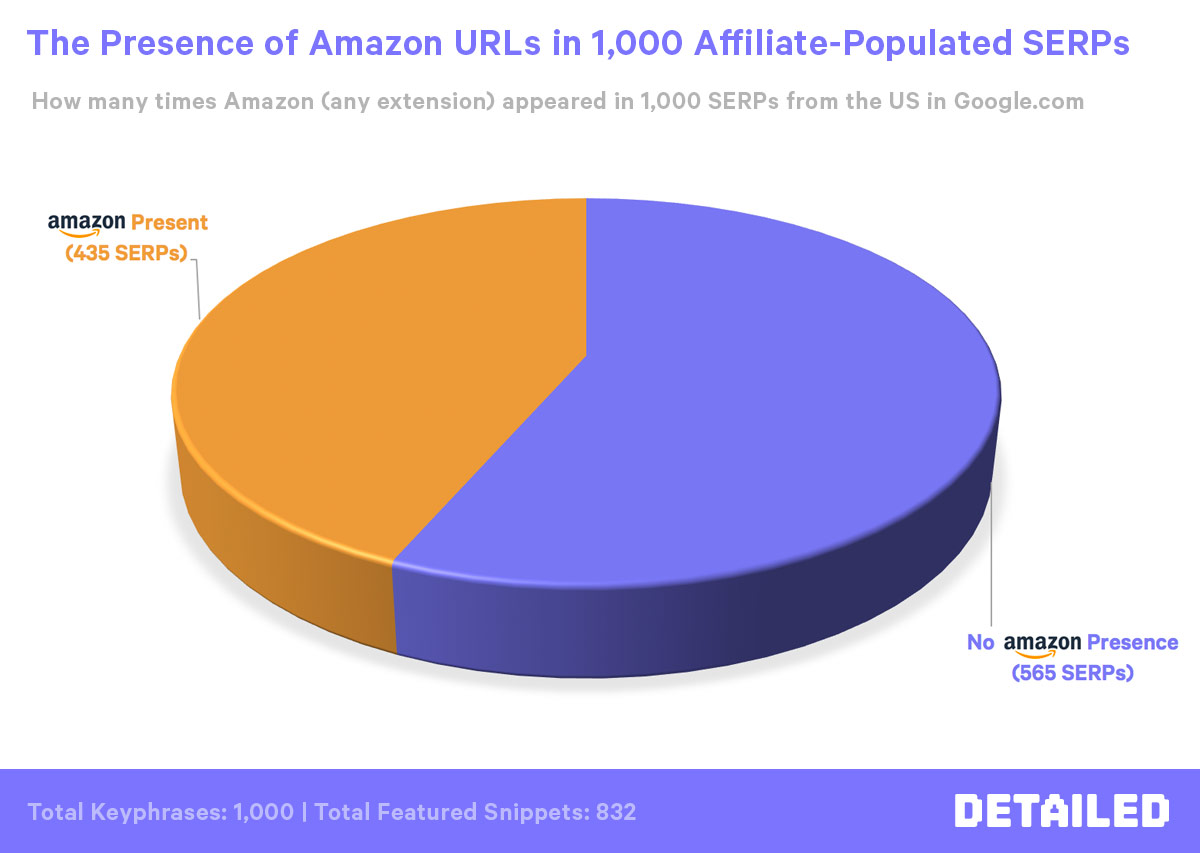
Out of 9,759 total URLs on the first page of Google, an Amazon result was 492 of them.
In 1,000 individual keyphrases analysed, Amazon ranked on the first page of search results for 435 (43.5%) of them.
I don’t know about you, but that number is higher than I expected.
Though they might not be as dominant as they first appear. Out of those 435 first page rankings, Amazon achieved:
- 17 first place rankings
- 23 second place rankings
- 46 third place rankings
In other words, when Amazon was present on the first page of rankings, it secured a number one ranking just 3.9% of the time.
It secured a number two ranking 5.2% of the time, and a third place ranking 10.5% of the time.
Those numbers drop to 1.7%, 2.3% and 4.6% respectively when you ignore whether Amazon was present or not.
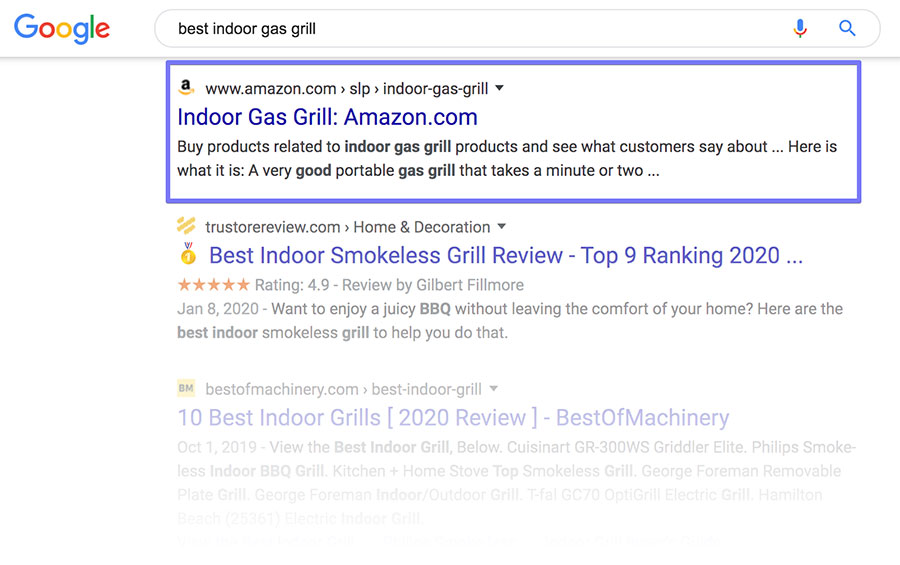
As we plan to monitor the same keyphrases going forward, Amazon’s growth or decline in these search results should be one of the most interesting things to keep track of.
Especially in terms of them starting to cover new markets and publishing more and more non-product content.
Domain Age: The Youngest Ranking Site Was Two Months Old
In our analysis which brought back 2,197 individual websites, at least 309 of them were less than three years old.
I say at least because our count is solely based on domains that were registered – for the first time in their history – in the last three years.
This means that we miss sites where a domain was registered a long time ago, and more recently it may have been used for one of the sites ranking.
In other words, it’s fair to say that a lot more than 309 sites were under three years old in terms of who owns them and what they’re now doing with the site, but we can confirm at least that many were.
So what can you achieve in a short period of time?
Here’s the stats for one website that is just nine months old:
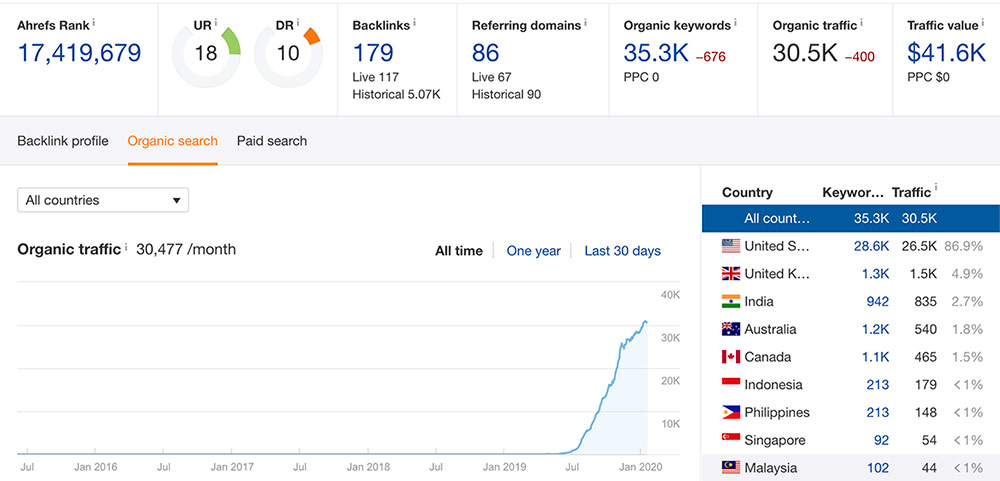
And here’s the stats for a website that is just seven months old:
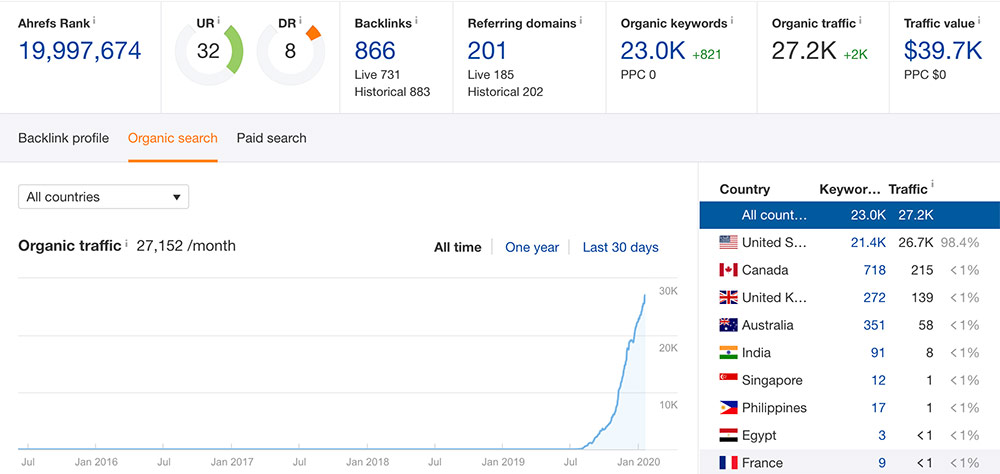
Note: These screenshots are at least 10 days old for their own privacy (so Ahrefs Rank has changed).
In neither case did we see evidence that another domain was redirected to them. They appear to have picked up solid links on their own merit.
However, the opposite was definitely the case for some of them. They either rebranded to another site and redirected their own domain, or redirected an expired domain.
This is the case for the domain that is only two months old, which was the youngest site ranking in our entire study.
If you want to know what the sites are – I don’t feel it’s right to share them in the open – I have an advanced keyword research guide which covers how to find them yourself (I’m pretty proud of that article).
Analysing Links Shows How Many Big Players are In the Affiliate Game
I planned to share this article with the world a week earlier.
Trying to be a good course creator (and hoping to get some feedback on the way), I shared a sneak peek of this article in private for a few hours with our SEO Blueprint members.
The feedback was great, but as soon as I shared it I felt some kind of link element was missing:
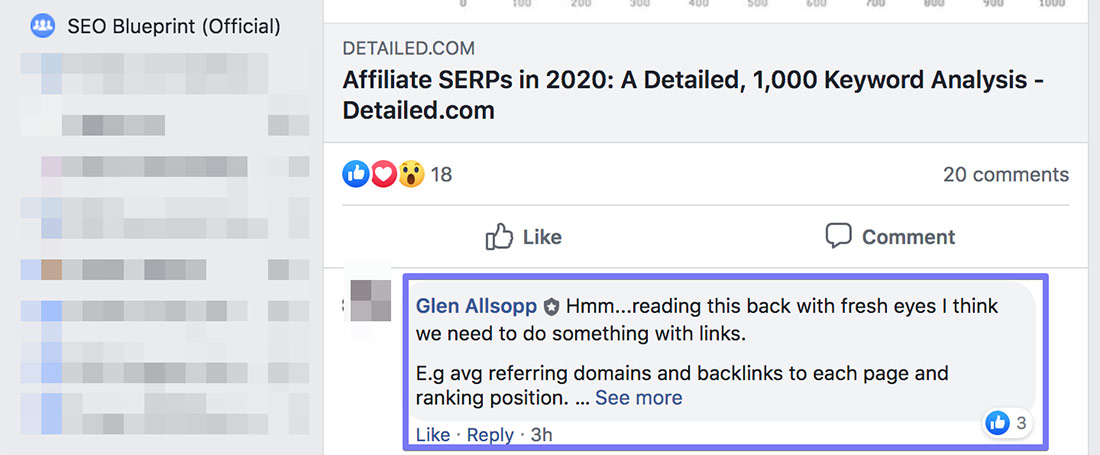
I would mention in a comment further down that I hadn’t performed a link analysis originally because I thought our scale (“only” checking 1,000 search results) would be too small to sense a proper pattern.
I was probably right.
Still, I renewed my Ahrefs API subscription a week earlier than planned so I may as well share the numbers.
First I pulled back the average number of referring domains for a website as a whole, rather than the specific URL that was ranking.
Here’s how that played out:
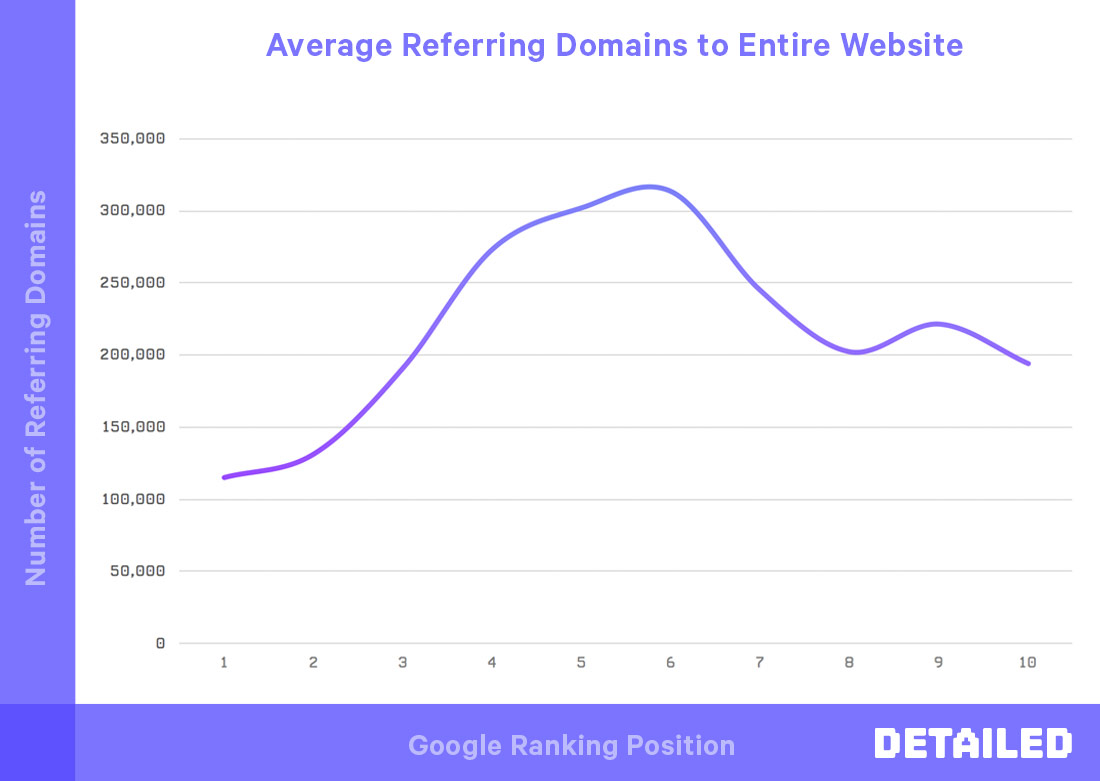
Looking at that graph, you’re right to feel a little confused.
Shouldn’t the sites with the most referring domains on average take most of the top spots?
Our scale is admittedly small, so don’t read into this section too much, but it looks like the opposite is true.
The most obvious reason is that some sites with ridiculous referring domain numbers tended to rank lower down page one. Sites like:
- BuzzFeed.com: 302,000 referring domains
- Forbes.com: 786,000 referring domains
- Amazon.com: 3,420,000 referring domains
- Wired.com: 426,000 referring domains
- BusinessInsider.com: 455,000 referring domains
As noted earlier, Amazon for example was present in a lot of the search results but didn’t tend to rank in the first few spots.
Next I pulled back the number of links to all of the top ranking URLs:
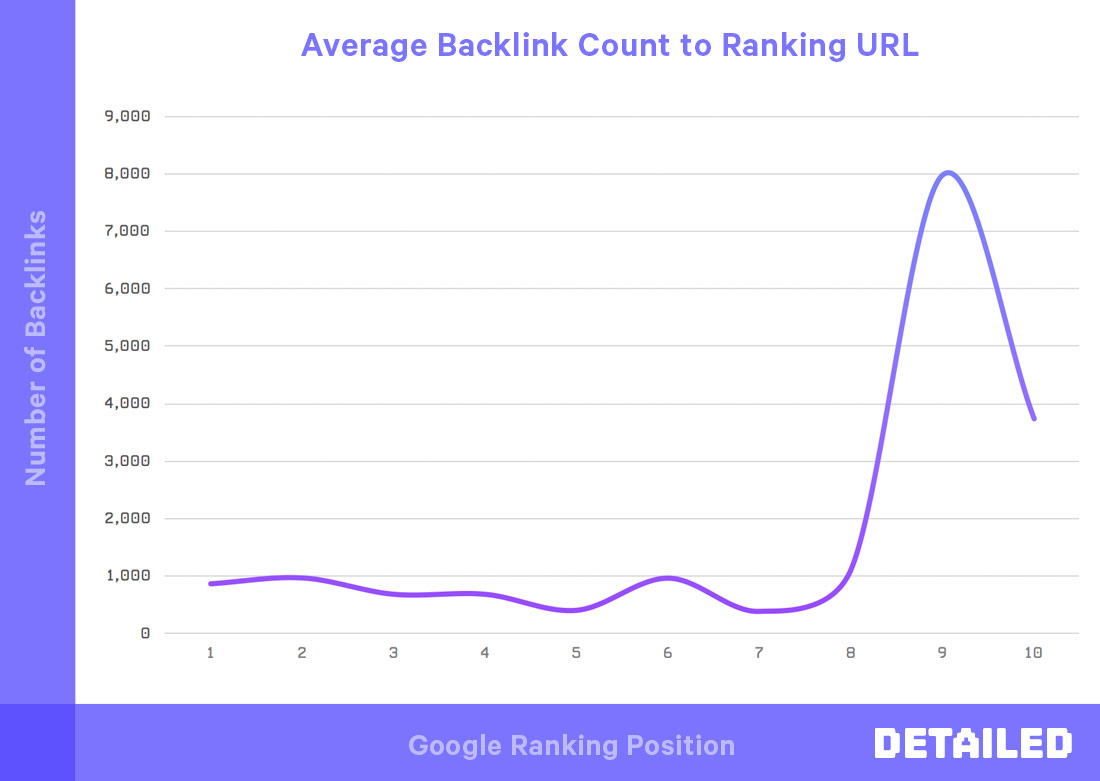
Once again, I’m fully aware that this graph looks like the opposite you would expect.
Links are a huge ranking factor, so surely sites with the most links to individual pages would be ranking better?
The first thing to keep in mind is that, of course, not all links are created equal.
There is a ton of junk in those link profiles, and once again it’s fair to criticise our scale, or lack of it, for this section.
Huge sites will always be in the top rankings from what we can tell, but when you’re only looking at 1,000 SERPs they bring the link numbers up much higher.
The best explanation I can give you for that graph is that when a homepage ranked, and sometimes they did for very huge brands, they tended to be at the end of search results.
As an example, if you’re looking for the best hardware wallet for your cryptocurrency, a lot of people promote Trezor and Ledger as affiliates.
Depending on what you search for however, both Trezor and Ledger homepages rank on the first page of Google. Each of those homepages have millions of links pointing to them which changes the numbers quite a bit.
Just to take this one step further, we also looked at followed links to top ranking URLs, though the results were mostly the same:
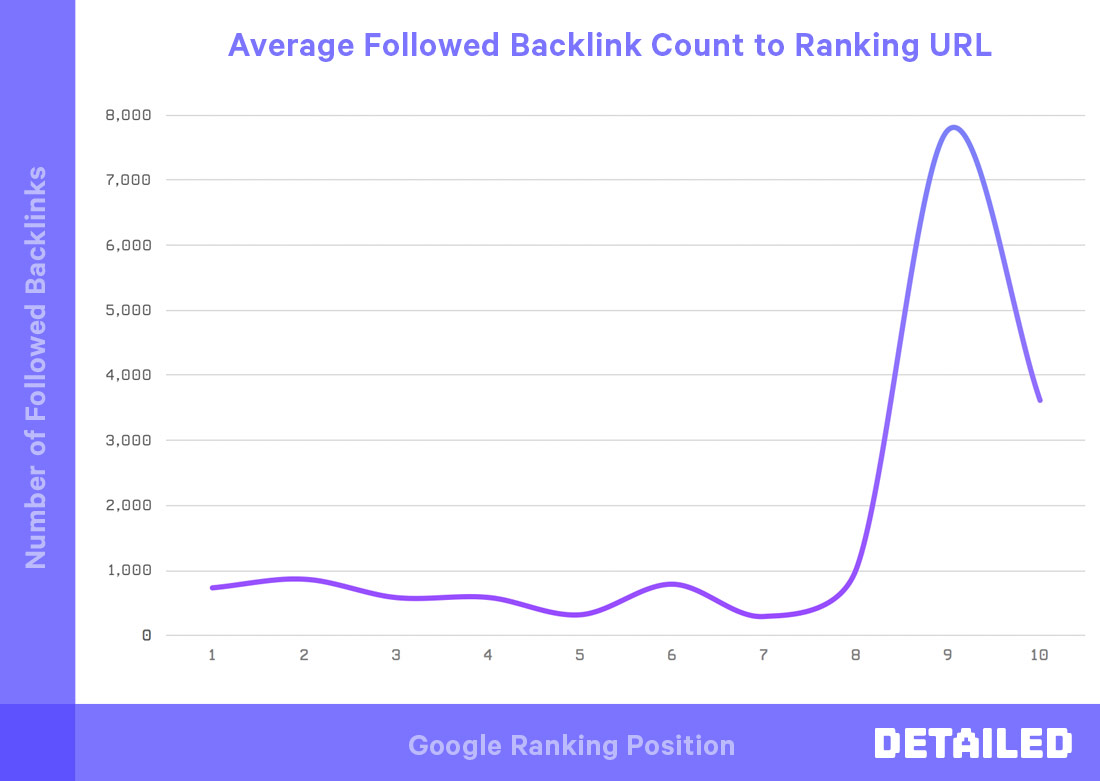
The lowest count on the chart overall was ranking position #7, with an average of 302 followed backlinks per ranking URL.
I was quite surprised by these numbers myself, so the above-mentioned homepage dilemma is one way to help explain the numbers.
However, there are some individual URLs with an insane number of backlinks.
Here’s one specific example:
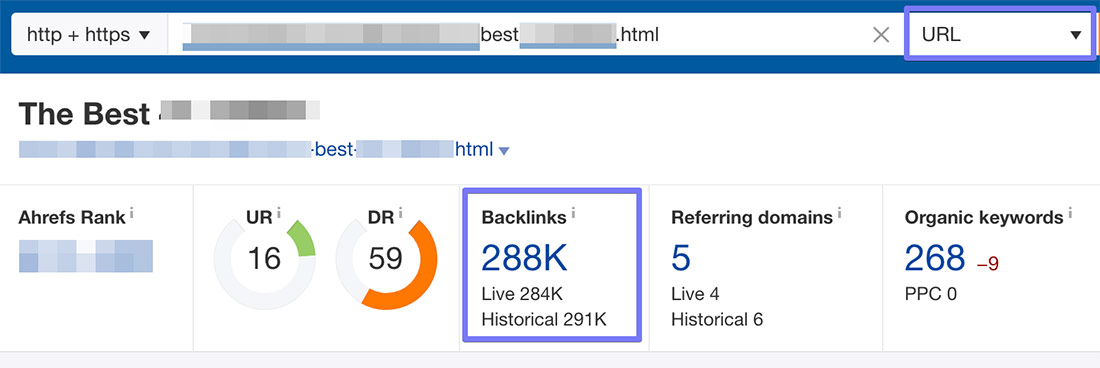
Though this URL was not used in our study, you can at least see how many links some URLs pick up.
It’s enough to see how extreme the backlink count can be, and may make you wonder why we don’t just look at referring domains to the top ranking URL.
Well, I’m back with the final graph for this section to do exactly that:
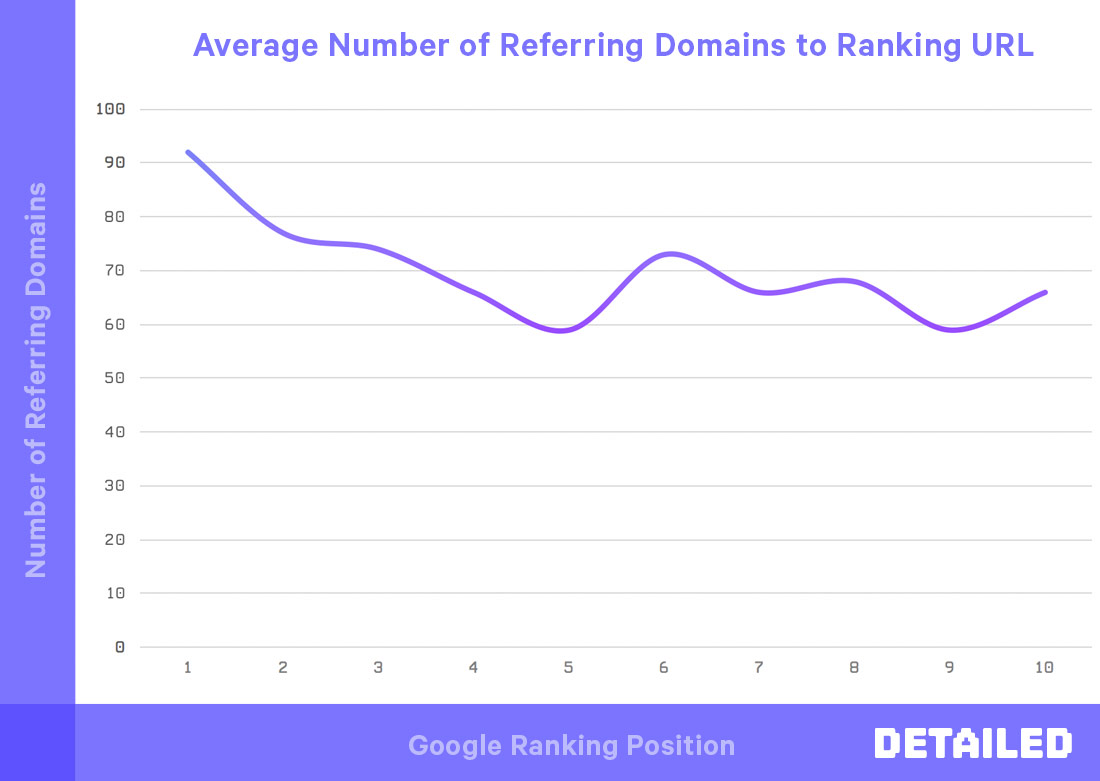
I like to think that’s a little more relatable and shows the kind of numbers you would expect.
The URLs with the most websites linking to them – rather than with the most links – ranked better than those further down search results.
Should You Try to Rank Your Homepage or an Internal Page?
It should be no surprise that internal pages are far more likely to rank than a homepage for a popular keyphrase.
After all, a website can have an unlimited number of internal pages, but only one homepage.
Still, I thought it would be fascinating to look at homepages as a whole, to see if anything stood out.
Overall, a homepage ranked on the first page of Google in 72 individual SERPs (7.2% of total).
The highest ratio of DR (Domain Rating) to page traffic came from a DR 2.1 domain, receiving an estimated 14,700 monthly visitors from Google.
Remember, that is solely for their homepage (though it does make up the majority of their overall traffic).

You might be a little frustrated seeing that.
They only have a few links and they’re getting a ton of traffic for an affiliate-populated keyword?
While they are in a pretty interesting niche, it’s very possible they’re hiding the links they’ve built.
For another example, here’s a DR 6 homepage that is getting around 1,300 visitors per month for an affiliate-populated phrase:

And here’s a DR 1 homepage getting around 1,400 visitors per month for an affiliate-populated phrase:

Other stats you might find interesting include:
- The most homepages present in a single SERP were three
- Three individual SERPs had three homepages ranking on them (all were different)
- Eleven individual SERPs had two homepages ranking on them (all were different)
- The most popular ranking homepage receives around 163,000 visitors per month from Google (it’s a well-known brand)
- Interestingly (to me), one SERP had two homepages ranking where their domain name was the same but one a .com and one a .net
Overall, for the most part, it looks like it makes more sense trying to optimise an individual page to rank for a specific keyphrase, rather than your homepage.
That said, some homepages are still performing very well, so I would advise checking the SERPs for the terms you’re targeting to see what Google are already rewarding.
The Most Popular Domain Extensions: Just How Dominant is Dot Com?
As someone who owns more domain names than I would like to admit, I couldn’t look at this data without being curious about which extensions were the most common.
Here were the most popular:

Other extensions we came across, ranked by their number of placements, include:
- .guide – 12 results
- .gov – 10 results
- .io – 6 results
- .me – 6 results
- .ca – 3 results
- .review – 3 results
- .com.au – 2 results
- .in – 2 results
- .info – 2 results
- .ly – 2 results
- .rocks – 2 results
- .tv – 2 results
- .ai – 1 result
- .be – 1 result
- .club – 1 result
- .cn – 1 result
- .expert – 1 result
- .it – 1 result
- .media – 1 result
- .pro – 1 result
- .site – 1 result
- .solutions – 1 result
- .tech – 1 result
I didn’t even know some of these extensions existed (e.g. .solutions) so this was pretty fun to dive into.
Exact Match & Partial Match Domains: Is There Any ‘Boost’?
In 563 of 1,000 SERPs, at least one partial match domain was present.
Partial match meaning the domain name of the site contained at least one word in common with the search query it appeared for.
The most partial match domains in a single SERP were seven, specifically for a golf-related product.
Just four exact match domains were found ranking for the queries we had searched for.
So if we had searched for ‘best home gym barbells’ (not an actual query), besthomegymbarbells.com appeared. Three were present with a .com extension, and one was present with a .review extension.
I should add that the number above is a little deceptive because there were many exact match domains ranking for popular affiliate queries that we simply didn’t include in our analysis.
For instance, we might have had the phrase ‘cheap mascara reviews’ in our dataset, with cheapmascara2020.com ranking. If we had more popular queries in our analysis – such as cheap mascara 2020 – then the number of exact match domains would have been much higher.
At least a dozen more exact match domains were ranking for popular queries that we didn’t analyse. They were just also ranking for terms that we did.
Three Reasons Many Top Ranking URLs No Longer Exist
One thing I considered doing with our data was putting together insights on title tag length, word count and more.
Word count is tricky since analysis tools pull back a lot of extra content that isn’t part of an article.
Still, I crawled every single URL and was surprised to see how many of the top ranking pages in our study no longer exist.
175 of the URLs from our study now redirect to another page.
In most cases, a change was simply made to the year in the URL. So sitename.com/best-leather-wallet-2019 became sitename.com/best-leather-wallet-2020.
It was quite funny to see how many people have now removed the year from their URLs so they don’t have to keep doing that, but many people went with 2020 for their new variation so will have to do the same thing again next year.
Six individual URLs now return a 404 (not found) status code.
Two pages from Amazon, and four pages from a running shoes website. The latter had URLs focused on targeting 2018 (not 2019 or 2020) and simply wrote new articles without redirecting the old ones.
I sent them an email to let them know, so fingers crossed they get that back.
The final reason a number of URLs no longer exist – though the website that was hosting them still does – is not something I’m sure I should talk about in the open.
It’s a bit like talking about PBNs before PBNs were popular. That last sentence should be enough.
SERP Features: The Most Popular, Ranked
Not only were we able to analyse the types of sites that were ranking well, but since we had all of the search result data to play with, we also looked at what features were present in the SERPs.
The SERP features most present in our 1,000 affiliate-focused keyphrases were:
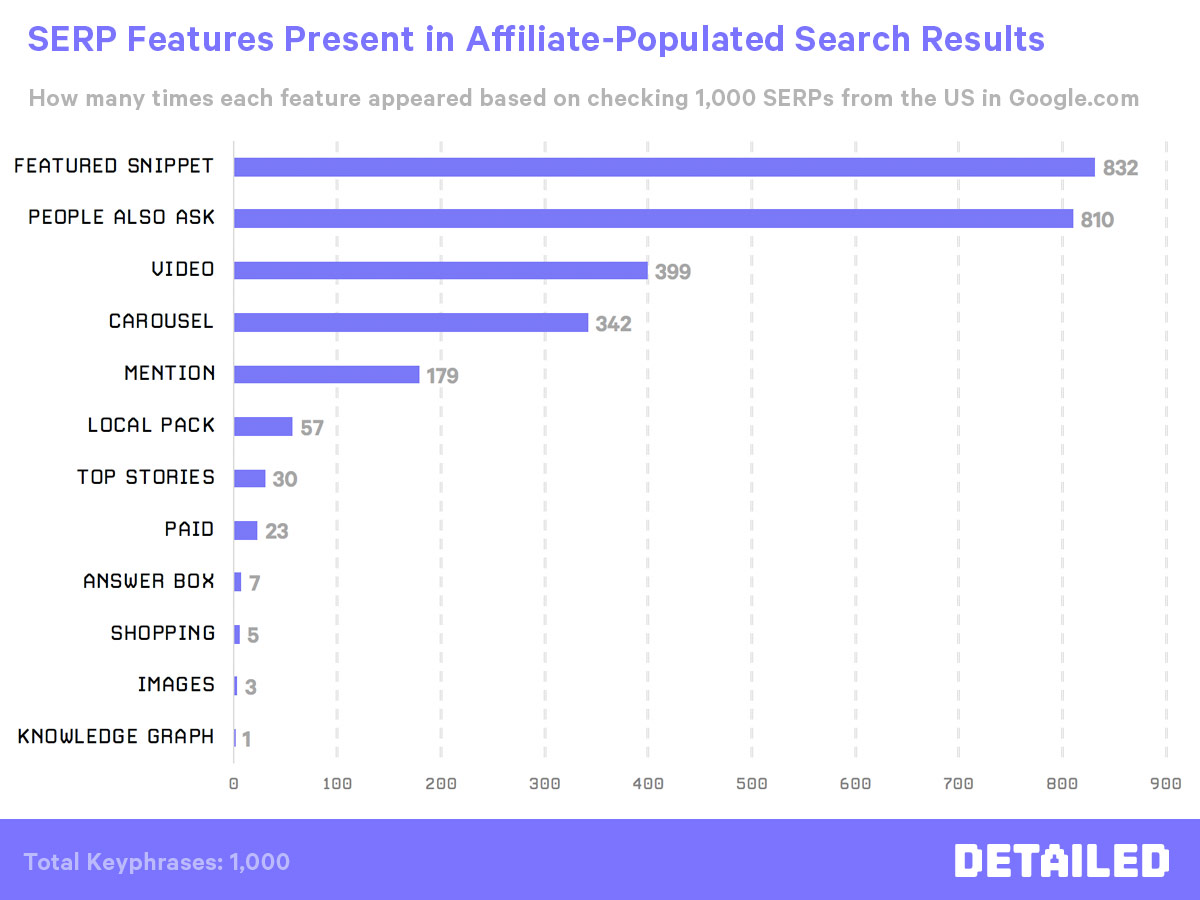
Most of the features should be self-explanatory, but Data for SEO (who we used to extract the features) have a great blog post outlining each one.
Miscellaneous URL Elements: Underscores, Subdomains and More
In another “We have the data so why not?” moment, I thought it would be interesting to see how many rankings were secure, how many had www in their URL, and more.
Here’s what we found:

I was quite surprised at this to be honest. I thought www and non-www would have been more like a 50/50 split.
Some people who are against subdomains might use this data as an argument to back up their viewpoint, but 5% of total results being on a subdomain was about what I would have expected personally.
And for one interesting fact (hopefully) that didn’t make it into the chart: The longest URL was 260 characters.
I won’t reveal the exact URL, but I can say it was from Bestbuy.com (who were also responsible for the second and third longest ranking URLs).
To put that length into context, here’s how a URL of that length looks:
website.com/this-is-an/example-of-how-long-the-longest/url-actually-was-which-was-ranking-on-the-first-page-of-google-for-one-of-the-queries-that-we-searched-for/i-know-it-looks-comically-long-but-its-true/best-buy-loves-long-urls-it-seems-im-almost-done
Finally, you might also be curious to note that 77 individual domains in total had a hyphen in them.
I’m not a fan of hyphens personally but they haven’t stopped those website owners from ranking well.
Notes and Improvements
It took weeks of work to put this analysis together, but it’s very clear to me that I think we need to go bigger.
There’s a good chance we’ll perform this analysis again with a bigger keyphrase set (more like 10,000 than 1,000) and solely focus on site-type rankings, rather than SERP features and domain extensions and similar.
That should also make tracking Amazon more insightful.
As mentioned above, we used DataforSEO to extract search results and SERP features, with a little more information on that here.
Until Next Time (Which is Actually Very Soon)
As mentioned throughout this post, one of the reasons we put so much time and energy into this is so that we can do it again.
Now that we have some kind of status check of how affiliate SERPs currently stand, we can watch the progress of big players over time (especially as we increase the number of keywords we track).
Even if search results change massively, we don’t have to define nearly as many websites in future updates.
The fun part is that Google rolled out the January algorithm update just days after we collected our data, so once that has died down we will be able to run the numbers again and see what changed.
If we combine news and general review sites, they are performing very well across the board, but having some kind of niche element to your website certainly seems like a smart approach that’s being rewarded (just keep our earlier caveats in mind).
The likes of BuzzFeed, Business Insider and NYMag are clearly saturating affiliate SERPs and judging by their publishing schedules, they show no signs of slowing down.
Whether they’ll continue to be rewarded in favour of more niche-focused sites should be interesting to monitor, so give this one a bookmark if you want to see the next edition.
Thank you for reading!
Correction: An earlier version of this article was missing three mentions from the top three results position graph (that’s three out of 3,000) that has now been fixed.








